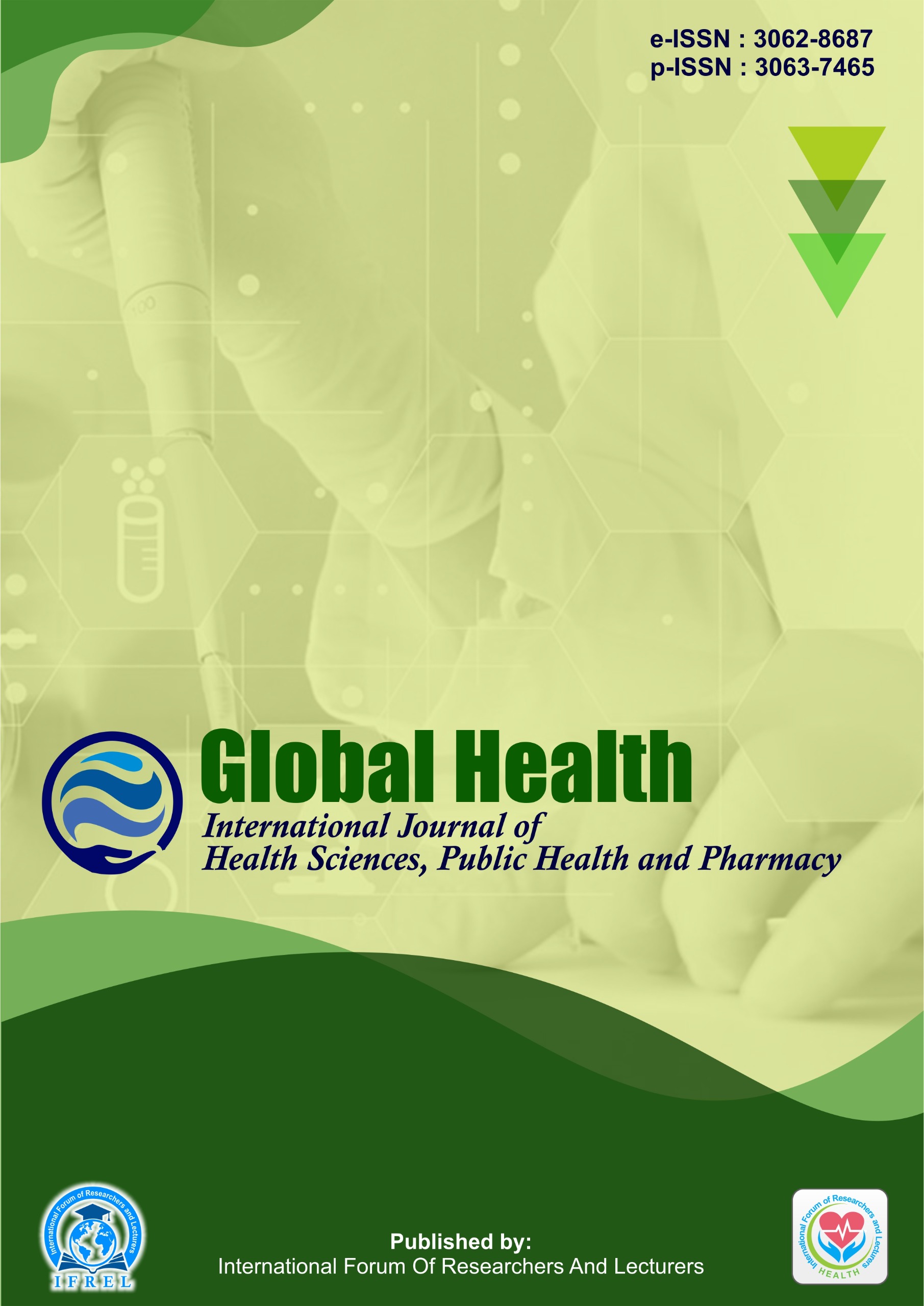A Procitentan, A New Novel Drug to Treat Resistant Hypertension
DOI:
https://doi.org/10.70062/globalhealth.v2i1.52Keywords:
Aprocitentan, Dual Endothelin Receptor Antagonist, Endothelin System, Endothelin, Resistant HypertensionAbstract
Resistant hypertension (RH) is defined as the failure to attain a controlled blood pressure in spite of the use of a triple combination therapy comprising a renin-angiotensin system inhibitor (RAS-i), a calcium antagonist, and a diuretic.Endothelin has been identified as a potential therapeutic agent target in the treatment of resistant hypertension. In hypertension and end-organ damage, endothelin plays a key role as a vasoconstrictor, comitogenic agent, and mediator of aldosterone and catecholamine release. ET inhibitors (receptor antagonist), currently approved by FDA in 2024 for the treatment of resistant and pulmonary hypertension. Aprocitentan seem to be also very useful for both essential hypertension and RH as well and could be used in combination of other hypertension drugs to get the best blood pressure control. Aprocitentan (Tryvio) is a novel new drug that administrated orally and showed well tolerated dual ET receptor antagonist, which has been inspected in numerous scientific studies and many clinical trials that showed hopeful results for RH control. As a result, that has been approved and optimistically it will help patients and prevent further cardiovascular disease and other organs damages. This article discusses several research that studied Aprocitentan from all aspects.
References
A Khalil, R. (2011). Modulators of the vascular endothelin receptor in blood pressure regulation and hypertension. Current Molecular Pharmacology, 4(3), 176–186.
Angeli, F., Verdecchia, P., & Reboldi, G. (2021). Aprocitentan, a dual endothelin receptor antagonist under development for the treatment of resistant hypertension. Cardiology and Therapy, 10(2), 397–406.
Arvanitis, L. V., Mewaldt, C., Krawisz, A., & Secemsky, E. A. (2025). Approach to resistant hypertension: A review of recent pharmacological advances. Current Treatment Options in Cardiovascular Medicine, 27(1), 1–10.
Boesen, E. I. (2015). Endothelin receptors, renal effects and blood pressure. Current Opinion in Pharmacology, 21, 25–34.
Booth III, J. N., Li, J., Zhang, L., Chen, L., Muntner, P., & Egan, B. (2017). Trends in prehypertension and hypertension risk factors in US adults: 1999–2012. Hypertension, 70(2), 275–284.
Boutari, C., & Siskos, F. (2023). Novel dual endothelin inhibitors in the management of resistant hypertension. Life, 13(806).
Carey, R. M., Calhoun, D. A., Bakris, G. L., Brook, R. D., Daugherty, S. L., Dennison-Himmelfarb, C. R., Egan, B. M., Flack, J. M., Gidding, S. S., & Judd, E. (2018). Resistant hypertension: Detection, evaluation, and management: A scientific statement from the American Heart Association. Hypertension, 72(1), e53–e90.
Carey, R. M., Sakhuja, S., Calhoun, D. A., Whelton, P. K., & Muntner, P. (2019). Prevalence of apparent treatment-resistant hypertension in the United States: Comparison of the 2008 and 2018 American Heart Association scientific statements on resistant hypertension. Hypertension, 73(2), 424–431.
Carretero, O. A., & Oparil, S. (2000). Essential hypertension: Part I: Definition and etiology. Circulation, 101(3), 329–335.
Clozel, M. (2022). Aprocitentan and the endothelin system in resistant hypertension. Canadian Journal of Physiology and Pharmacology, 100(6), 573–583.
Cushman, W. C., & Basile, J. (2006). Achieving blood pressure goals: Why aren’t we? The Journal of Clinical Hypertension, 8(12), 865–871.
Danaietash, P., Verweij, P., Wang, J. G., Dresser, G., Kantola, I., Lawrence, M. K., Narkiewicz, K., Schlaich, M., Bellet, M., & Investigators, P. (2022). Identifying and treating resistant hypertension in PRECISION: A randomized long‐term clinical trial with aprocitentan. The Journal of Clinical Hypertension, 24(10), 804–813.
Dhillon, S. (2024). Aprocitentan: First approval. Drugs, 84(1), 1–7.
Flack, J. M., Buhnerkempe, M. G., & Moore, K. T. (2024). Resistant hypertension: Disease burden and emerging treatment options. Current Hypertension Reports, 26(1), 1–17.
Fontes, M. S., Dingemanse, J., Halabi, A., Tomaszewska-Kiecana, M., & Sidharta, P. N. (2022). Single-dose pharmacokinetics, safety, and tolerability of the dual endothelin receptor antagonist aprocitentan in subjects with moderate hepatic impairment. Scientific Reports, 12(1), 19067.
Genovesi, S., Giussani, M., Orlando, A., Lieti, G., Viazzi, F., & Parati, G. (2022). Relationship between endothelin and nitric oxide pathways in the onset and maintenance of hypertension in children and adolescents. Pediatric Nephrology, 37(3), 537–545.
Gueneau de Mussy, P., Sidharta, P. N., Wuerzner, G., Maillard, M. P., Guérard, N., Iglarz, M., Flamion, B., Dingemanse, J., & Burnier, M. (2021). Effects of the dual endothelin receptor antagonist aprocitentan on body weight and fluid homeostasis in healthy subjects on a high sodium diet. Clinical Pharmacology & Therapeutics, 109(3), 746–753.
Heidari Nejad, S., Azzam, O., & Schlaich, M. P. (2023). Dual endothelin antagonism with aprocitentan as a novel therapeutic approach for resistant hypertension. Current Hypertension Reports, 25(5), 343–352.
Iglarz, M., & Clozel, M. (2007). Mechanisms of ET-1-induced endothelial dysfunction. Journal of Cardiovascular Pharmacology, 50(6), 621–628.
Jankowich, M., & Choudhary, G. (2020). Endothelin-1 levels and cardiovascular events. Trends in Cardiovascular Medicine, 30(1), 1–8.
Ji, Y., Duan, J., Yuan, Q., He, X., Yang, G., Zhu, S., Wu, K., Hu, W., Gao, T., & Cheng, X. (2023). Structural basis of peptide recognition and activation of endothelin receptors. Nature Communications, 14(1), 1268.
Kario, K., Okura, A., Hoshide, S., & Mogi, M. (2024). The WHO Global report 2023 on hypertension warning the emerging hypertension burden in globe and its treatment strategy. Hypertension Research, 47(6), 1099–1102.
Kuiper, J. W., Versteilen, A. M., Niessen, H. W., Vaschetto, R. R., Sipkema, P., Heijnen, C. J., Groeneveld, A. B. J., & Plötz, F. B. (2008). Production of endothelin-1 and reduced blood flow in the rat kidney during lung-injurious mechanical ventilation. Anesthesia & Analgesia, 107(4), 1276–1283.
Motte, S., McEntee, K., & Naeije, R. (2006). Endothelin receptor antagonists. Pharmacology & Therapeutics, 110(3), 386–414.
Oparil, S., Zaman, M. A., & Calhoun, D. A. (2003). Pathogenesis of hypertension. Annals of Internal Medicine, 139(9), 761–776.
Parodi, R., Brandani, L., Romero, C., & Klein, M. (2024). Resistant hypertension: Diagnosis, evaluation, and treatment practical approach. European Journal of Internal Medicine.
Phillips, B., Vascimini, A., Whitner, C., St. Onge, E., & Huston, J. (2024). Pressing update: Aprocitentan for the treatment of hypertension. Annals of Pharmacotherapy.
Downloads
Published
How to Cite
Issue
Section
License
Copyright (c) 2025 Global Health: International Journal of Health Sciences, Public Health and Pharmacy

This work is licensed under a Creative Commons Attribution-ShareAlike 4.0 International License.





